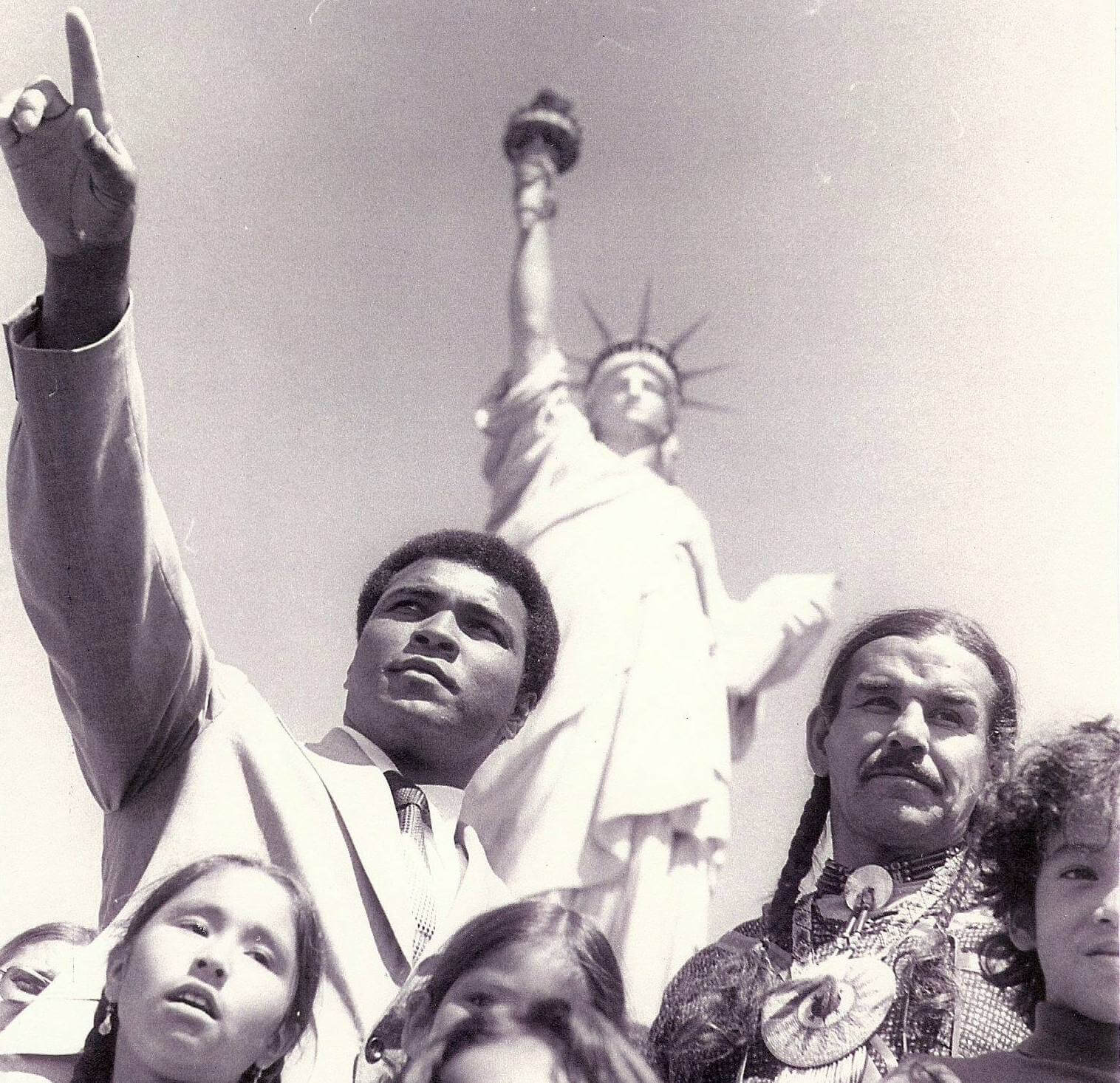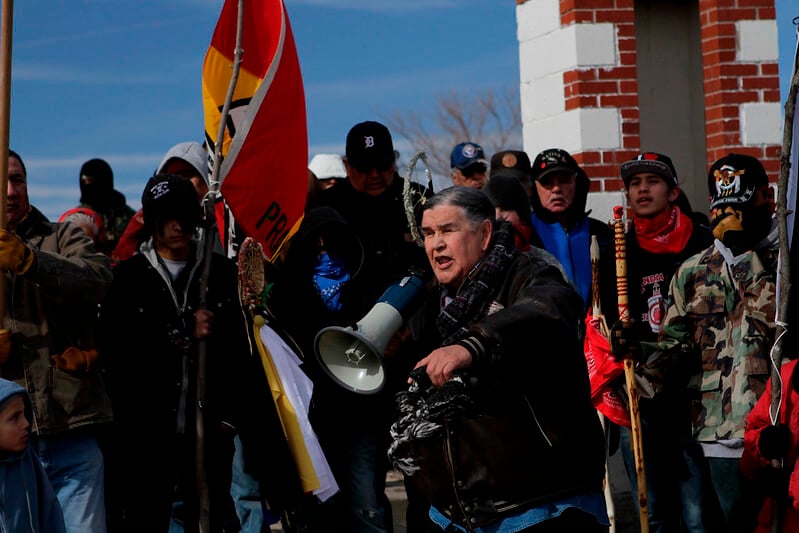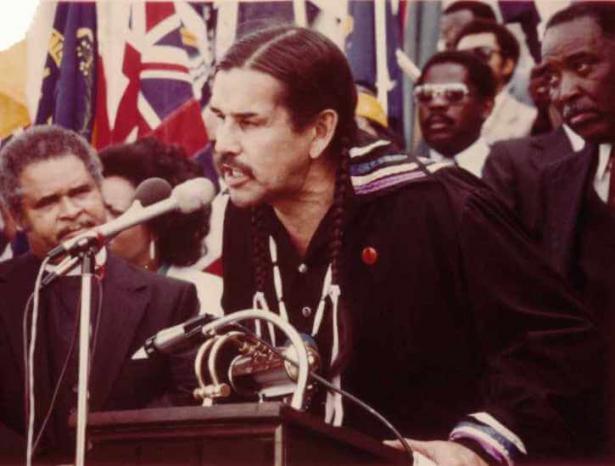I HAD SHORT HAIR the first time I met Clyde Bellecourt. It was Native American Heritage Month in 2005. Native students had invited him and fellow members of the American Indian Movement (AIM) to the University of South Dakota after police plastered posters on campus depicting a poorly drawn “Native American male” who had allegedly attacked a woman. The description was vague enough to implicate just about anyone; several students and university workers were called in for questioning. The posters were vulgar because of their bluntness: they appeared to confirm the worst stereotypes of savage Indians attacking innocent women.
So AIM called a press conference. They brought in the big drum. The AIM song, known as the “Raymond Yellow Thunder Song,” boomed so loudly from the campus dining hall I heard it in the parking lot. And a prayer was said with the canupa, a ceremonial pipe. The event quickly turned into a demonstration, as AIM leaders sat in judgement of university and law enforcement officials. Bellecourt likened the actions of police to “that old John Wayne frontier mentality.” It didn’t help that the chief of police, Art Mabry, had an unfortunate resemblance to the Duke, that Hollywood cowboy who spent a lot of time on-screen killing Indians. Mabry’s face flushed red as several people from the crowd snickered. One by one, community members testified to the daily humiliations they faced at the hands of white authority. It was an AIM signature, the Red Ribbon Grand Jury, a people’s court, that was first hosted in 1968 to hold government officials to account.
The tables had turned that evening. No concrete actions or apologies came from either side, but attitudes shifted. Bellecourt and AIM taught us something that they had been teaching Native people for nearly half a century: colonizing society is weak because of its sense of superiority. It has God, guns, and gold, but its soft underbelly is glory.
That memory came rushing back to me last week when I learned of Bellecourt’s death. He passed at his home in Minneapolis at the age of eighty-five. AIM has been largely caricatured in the media as a group of violent, larger than life men with braids and shades. (Women in the movement have largely been ignored, if not nearly forgotten.) It’s true that armed takeovers and occupations—such as at Wounded Knee 1973, which Bellecourt helped organize—launched AIM to international prominence. Those actions were no doubt important. But perhaps AIM is really defined by what Bellecourt called “the damn hard work,” which doesn’t make headlines, of fighting for affordable housing, youth educational and cultural programs, and legal aid for poor and urban Indians. That work began well before Wounded Knee and has carried on since. “We were just getting going,” Bellecourt said of AIM after Wounded Knee.

Cyle Bellecourt and Muhammad Ali during The Longest Walk, 1978. | American Indian Movement Interpretive Center
Bellecourt was born in 1936 on the White Earth Indian Reservation in present-day northwest Minnesota. He was the seventh of twelve children growing up in a home with no electricity or running water. Both of Bellecourt’s parents suffered lifelong physical disabilities. His father Charles, a survivor the notorious, government-run Carlisle Indian Industrial School, was wounded in World War I. As punishment for speaking Anishinaabe, nuns crippled his mother Angeline when she was a child by making her scrub floors for hours while kneeling on bags of marbles. She walked with a limp for the rest of her life.
Like many of the founders of AIM, Bellecourt was profoundly shaped by his experience of being stolen away from his family to church- or state-run schools. As a boy, he attended a Catholic school run by nuns from St. Benedict’s Mission. His hands bore the scars of a nun’s ruler. He often cut class, escaping to nearby forests and lakes for hunting and fishing. Later, a judge sentenced him to a correctional school off-reservation for truancy. In the book The Thunder Before the Storm which he co-wrote with Jon Lurie, Bellecourt recounts being sexually abused by a Catholic priest and forced into hard labor.
When he was sixteen, his family moved to Minneapolis, where Bellecourt dropped out of high school and struggled to find a job. He turned to drinking, burglary, and robbery and was jailed. At Stillwater Prison, after a harrowing stint in solitary confinement, he met Eddie Benton-Banai, an Ojibwe from Wisconsin. The two began running cultural programs and sweat lodge ceremonies for Native inmates. The Indian Folklore Group, as it was known, taught Native history and language. For the first time in the prison’s history, spiritual leaders were allowed to conduct Midewin ceremonies and purification rites that Bellecourt described as leading him “down a healing path.” Reconnecting with culture and spirituality was transformative for him and hundreds like him. “There was an Indian renaissance going on in that prison,” he recalled.
After his release in mid-1968, Bellecourt teamed up with former inmates, including Benton-Banai and a charismatic Ojibwa named Dennis Banks, to “transpose our Native American studies program to the streets of Minneapolis.” They formed the American Indian Movement that July with others like Pat Bellanger, Annette Oshie, Harold Goodsky, and George Mitchell. Bellecourt was its first chairman. AIM started out as a community forum, where Native people brough their problems and complaints about police, schools, housing, jobs, and discrimination. Their quick response and organizing earned them the respect of their base. Bellecourt had worked for a utility company after prison, but he soon quit to dedicate himself full-time to the movement. While protesting the Vietnam War, he met his future wife Peggy Sue Holmes, the daughter of an Anishinaabe woman and a Japanese man who was once interned in a war relocation camp. They had four children together.
AIM set its sights on combating Indian child removal, police violence, and poverty. (Later, its objectives evolved to include tribal sovereignty and the unification of all Indian people.) Federal policies of termination and relocation pushed Native people to cities promising jobs and the American dream. What they found were dire conditions—unemployment, poor housing, and rampant discrimination—that were sometimes worse than reservation life. Relocation wasn’t the only form of elimination. Indian child removal was just as devastating. Two studies by the Association on American Indian Affairs conducted in 1969 and 1974 found that 25 to 35 percent of all Native children had been separated from their families and placed into foster homes or adoptive institutions. In Minnesota in 1978, more than ninety percent of nonrelated adoptions of Indian children were made by non-Indian couples. “We had been raised in the foster system, the boarding school system, the criminal justice system, and by parents who’d had the Indian beaten out of them,” Bellecourt wrote of the people he organized with during those early years. “The thing that bothered me the most was not knowing where my nephews and my nieces and my family were,” he told the Osage historian Amy Lonetree in 2012. “So this was burning inside me when the American Indian Movement formed.”
The credo of AIM became “anytime, anywhere, any place.” The AIM Patrol, which kept an eye on cops in Indian neighborhoods, deployed at a moment’s notice, often intervening during raids on Indian bars. The confrontational tactics that were effective at curbing the most egregious forms of police violence became a mainstay of the organization. In 1970, AIM occupied the Denver Bureau of Indian Affairs (BIA) office to protest its not hiring Native employees. The action snowballed as BIA offices were occupied in Chicago, Alameda, Minneapolis, Philadelphia, Cleveland, Dallas, Los Angeles, and Albuquerque—AIM “became a national movement overnight,” according to Bellecourt. The actions earned them a reputation as vanguards for the Indian revolution that seemed to be underway. One year earlier, Native students had taken over the federal prison at Alcatraz Island declaring it Indian territory.
During those tumultuous years, from 1970 to 1971, Banks and Bellecourt traveled the country at the invitation of the government-run program through the National Council on Indian Opportunity, as part of a national survey of Indian economic conditions on- and off-reservation. They made national connections that helped spread the message of AIM, and the experience was eye-opening. They discovered that Natives had the highest infant mortality rate and terrible rates of suicide; that they suffered substandard housing and lack of running water; that high school dropouts and unemployment were rampant; that police violence and incarceration were disproportionate. “The information was shocking,” Bellecourt recalled, “even to those of us who lived it.” In the Twin Cities, they collaborated with Black activists to establish the Legal Rights Center to provide poor Black, white, and Native families with legal aid. (Keith Ellison, Minnesota’s current Attorney General, was the Center’s former executive director.) They took control of the Little Earth Housing Project, which provided affordable housing to Native families, and helped set up survival schools like Heart of the Earth and Red School House, teaching youth Native culture and history as an alternative to the public school system. Nearly forty AIM schools sprung up throughout the United States and Canada.
By 1972, AIM had tens of thousands of members and chapters in every region of the United States. That year, Bellecourt organized a coast-to-coast march to Washington, D.C. The Trail of Broken Treaties, which was mostly written by Hank Adams, was a twenty-point indictment of U.S-Indigenous relations that also offered solutions such as beginning a new era of treaty-making. A coalition of Native organizations planned to deliver the document to the Nixon administration. AIM ended up leading a take over the BIA headquarters in Washington, renaming it “The Native American Embassy.”
The action riled tribal officials and the political elite. But it won AIM respect among reservation-based elders and traditionals, who called them to the Pine Ridge Indian Reservation, first to address rampant border town violence, such as the killings of Raymond Yellow Thunder in Gordon, Nebraska, and of Wesley Bad Heart Bull in Hot Springs, South Dakota. The demonstration in Gordon led to the conviction of Yellow Thunder’s killers; a second action in Custer, South Dakota, ended in a riot at the courthouse. It was in Lakota Country in 1970 that Bellecourt experienced another spiritual awakening revitalization. He was introduced to the young Lakota medicine man Leonard Crow Dog, who became the movement’s spiritual advisor. Bellecourt made his vows on the canupa and attended his first sun dance with Russell Means, whose star as an AIM leader was fast rising.
In February 1973, Bellecourt and AIM leadership led an armed takeover of the Wounded Knee Massacre site. They declared independence from the United States and demanded the restoration of treaty rights to the Great Sioux Nation, or the Oceti Sakowin. Bellecourt claimed it was a “non-violent” action that turned violent because of state aggression. Federal troops fired tens of thousands of rounds on AIM, who had hunting rifles and shotguns. Two members were killed and hundreds arrested, as the organization’s leadership was tied up. A medicine man gave Bellencourt the Anishinaabe name Neegawnwaywidung—“Thunder Before the Storm”—after the seventy-one-day siege.
During the Wounded Knee trials of Dennis Banks and Russell Means, it became increasingly clear that the FBI was out to destroy AIM. (In 1974, their case was dismissed for prosecutorial misconduct, a decision upheld on appeal.) Tensions and suspicions rose about suspected infiltration. Nearly sixty AIM members died during the FBI’s “Reign of Terror” following Wounded Knee. Factional disputes also intensified. Carter Camp, a Ponca AIM leader from Oklahoma, shot Bellecourt on the Rosebud Indian Reservation in 1973, nearly killing him. Bellecourt suspected that Camp was working for the FBI but refused to testify, instead opting to handle it the “traditional way.” Police surveillance and political pressures mounted causing splinters in AIM, turning relatives and former friends against each other.
It seemed like the AIM was on the brink of collapse when it formed the International Indian Treaty Council in 1974, transposing a largely U.S.-based struggle into an international Indigenous movement. The twenty points Bellecourt and others drafted for the Trail of Broken Treaties became the basis for four decades of work at the United Nations and led to the 2007 UN Declarations on the Rights of Indigenous Peoples. With his older brother Vernon Bellecourt and longtime confidant Bill Means, Bellecourt also strengthened international relationships with liberation organizations like the Sandinistas in Nicaragua and Irish Republican Army and Sinn Fein in Ireland. Vernon died in 2007, not long after visiting Venezuela, where he spoke to Hugo Chavez about providing heating assistance to Indian reservations. (In 2007, Montana and South Dakota tribes received over a million dollars in a private donation from from CITGO Petroleum Corporation, which is majority-owned by the Venezuelan state.)
In 1991, the Bellecourt brothers formed the National Coalition on Racism in Sports and Media. Their actions included filing lawsuits against sports teams with racist logos and mascot and marches in protest. A measure of their success is that in recent years, the Washington Football Team and Cleveland Baseball Team have both retired racist mascots.

Cyde Bellecourt at Liberation Day 4 Direction Walk 2014. | Flickr
I had long hair, wearing it in the style of my ancestors, the last time I saw Cyde Bellecourt. It was at the Standing Rock prayer camps erected in 2016 against the Dakota Access Pipeline. A journalist with a camera was asking Bellecourt, now an old man, why he was there. He seemed annoyed. “Because this is what we do,” he told her, letting out a smile.
Bellecourt balked at being called a “civil rights leader.” “Indian people were demonstrating for a hell of long time before Martin Luther King and before the Constitution was ever enacted in this country,” he said at a talk in 1971. “And Indian people have been demonstrating to this system . . . at least since the white man got here.” If journalists are the first to write history, they can also be guilty of getting that history wrong. Bellecourt’s hometown newspaper the Star Tribune called him a “longtime civil rights leader” in the headline announcing his death. I imagine him smiling about that one, too.
After the camps left Standing Rock, the damn hard work continued on other frontlines, like Line 3 in Bellecourt’s homelands. George Floyd was murdered by police not far from where Bellecourt lived with his wife Peggy Sue. A new generation picked up where he left off, and the AIM Patrol got to work during the uprising of 2020. After Bellecourt left this world for the next, the damn hard work continues with the urban Indian housing projects, language schools, the Legal Rights Center, and Indian health boards—the living legacies of AIM in Minneapolis.
Nick Estes is a citizen of the Lower Brule Sioux Tribe. He is an assistant professor of American studies at the University of New Mexico and is the author of Our History Is the Future: Standing Rock Versus the Dakota Access Pipeline, and the Long Tradition of Indigenous Resistance.
The Baffler: In a media environment that tolerates tail-chasing, gutlessness, and all kinds of ratfuckery, The Baffler is a rare publication willing to shake the pundit class free of their own worst impulses. We can’t help it. We’re humanitarians at heart.
But running a charitable organization of this magnitude requires serious dough, and subscriptions only cover a fraction of our costs. For the rest, we rely on the good will of generous readers like you.
So if you like the article you just read—or hate it, and want us to publish more just like it, so you can ridicule us online for years to come—please consider making a one-time donation to The Baffler. $5, $10, $2,000… we’re not picky. Anything helps.


Spread the word